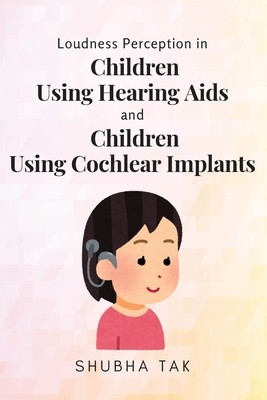
- We will send in 10–14 business days.
- Author: Shubha Tak
- Publisher: independent Author
- ISBN-10: 4782645988
- ISBN-13: 9784782645987
- Format: 15.2 x 22.9 x 1 cm, minkšti viršeliai
- Language: English
- SAVE -10% with code: EXTRA
Loudness Perception in Children Using Hearing Aids and Children Using Cochlear Implants (e-book) (used book) | bookbook.eu
Reviews
Description
The study compared two loudness perception measures (loudness growth identification & intensity discrimination) in children using a single cochlear implant (n = 25), children using binaural hearing aids (n = 20), and typically developing children (n = 31). In the children using hearing aids, the effect of compression parameters on loudness perception was also evaluated in three different conditions (own prescribed hearing aids, linear hearing aids, & non-linear hearing aids). While the participants' own hearing aids had lesser compression compared to the non-linear hearing aids, the linear hearing aids had no compression. The children aged 6 to 15 years, were evaluated using three warble tones (500 Hz, 1000 Hz, & 4000 Hz) and three vowels (/u/, /a/, & /i/). Loudness growth was measured using a 'Loudness growth chart' having six loudness levels (very soft, soft, comfortable, loud, too loud, & very loud, & painting) and intensity discrimination was assessed using Psychon software. Only 48% of the children using cochlear implants and 65% of children using hearing aids could give consistent responses in the loudness growth identification test, while all typically developing children could do so. Further, on the loudness growth test, among the hearing aid users, no significant difference occurred between the three hearing aid conditions for most stimuli. Across the three participant groups, significant differences were obtained mainly for the soft loudness levels for most stimuli. Both the clinical groups required more intensity to perceive the softer loudness levels compared to the normal-hearing children. However, the children using cochlear implants did not differ significantly from the children using hearing aids for most loudness levels and stimuli.
- Author: Shubha Tak
- Publisher: independent Author
- ISBN-10: 4782645988
- ISBN-13: 9784782645987
- Format: 15.2 x 22.9 x 1 cm, minkšti viršeliai
- Language: English English
The study compared two loudness perception measures (loudness growth identification & intensity discrimination) in children using a single cochlear implant (n = 25), children using binaural hearing aids (n = 20), and typically developing children (n = 31). In the children using hearing aids, the effect of compression parameters on loudness perception was also evaluated in three different conditions (own prescribed hearing aids, linear hearing aids, & non-linear hearing aids). While the participants' own hearing aids had lesser compression compared to the non-linear hearing aids, the linear hearing aids had no compression. The children aged 6 to 15 years, were evaluated using three warble tones (500 Hz, 1000 Hz, & 4000 Hz) and three vowels (/u/, /a/, & /i/). Loudness growth was measured using a 'Loudness growth chart' having six loudness levels (very soft, soft, comfortable, loud, too loud, & very loud, & painting) and intensity discrimination was assessed using Psychon software. Only 48% of the children using cochlear implants and 65% of children using hearing aids could give consistent responses in the loudness growth identification test, while all typically developing children could do so. Further, on the loudness growth test, among the hearing aid users, no significant difference occurred between the three hearing aid conditions for most stimuli. Across the three participant groups, significant differences were obtained mainly for the soft loudness levels for most stimuli. Both the clinical groups required more intensity to perceive the softer loudness levels compared to the normal-hearing children. However, the children using cochlear implants did not differ significantly from the children using hearing aids for most loudness levels and stimuli.


Reviews